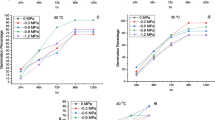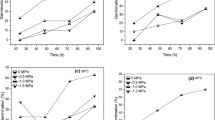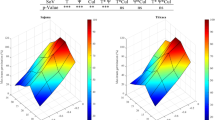Abstract
To quantify both temperature (T) and water potential (ψ) effects on sesame (Sesamum indicum L.) seed germination (SG) and also to determine the cardinal T s for this plant, a laboratory experiment was carried out using hydrothermal time model (HTT). For this purpose, four sesame cultivars (‘Asbomahalleh’, ‘Darab’, ‘Dashtestan’ and ‘Yellowhite’) were germinated at seven constant T s (20, 25, 30, 35, 37, 39 and 43 °C) at each of the following ψ s (0, − 0.12, − 0.24 and − 0.36 MPa; provided by PEG 8000). Germination rate (GR) and germination percentage (GP) significantly influenced by ψ, T and their interactions in all cultivars (P ≤ 0.01). There was no significant difference, based on the confidence intervals of the model coefficients, between cultivars, so an average of cardinal T s was 14.7, 35.4 and 47.2 °C for the minimum (T b), optimum (T o) and maximum (T c) T s, respectively, in the control condition (0 MPa). Hydrotime values in all cultivars decreased when T was increased to T o and then remained constant at T s > T o (15 MPa h−1). An average value of ψ b(50) was estimated to be − 1.23 MPa at T s ≤ T o and then increased linearly (0.1041 MPa°Ch−1, the slope of the relationship between ψ b(50) and supra-optimal T s) with T when T s increased above T o and finally reached to zero at T c. The T b and T o values were not influenced by ψ, but T c value decreased (from 47.2 for zero to 43.5 °C for − 0.36 MPa) at supra-optimal T s as a result of the effect of ψ on GR. Based on our findings, this model (as a predictive tool) and or the estimated parameter values in this study can easily be used in sesame SG simulation models to quantitatively characterize the physiological status of sesame seed populations at different T s and ψ s.



Similar content being viewed by others
References
Alvarado V, Bradford K (2002) A hydrothermal time model explains the cardinal temperatures for seed germination. Plant Cell Environ 25:1061–1069
Angus J, Cunningham R, Moncur M, Mackenzie D (1980) Phasic development in field crops I. Thermal response in the seedling phase. Field Crops Res 3:365–378
Atashi S, Bakhshandeh E, Zeinali Z, Yassari E, Teixeira da Silva JA (2014) Modeling seed germination in Melisa officinalis L. in response to temperature and water potential. Acta Physiol Plant 36:605–611
Atashi S, Bakhshandeh E, Mehdipour M, Jamali M, Teixeira da Silva JA (2015) Application of a hydrothermal time seed germination model using the Weibull distribution to describe base water potential in zucchini (Cucurbita pepo L.). J Plant Growth Regul 34:150–157
Bahrami H, Razmjoo J, Jafari AO (2012) Effect of drought stress on germination and seedling growth of sesame cultivars (Sesamum indicum L.). Int J AgriSci 2:423–428
Bakhshandeh E, Atashi S, Hafeznia M, Pirdashti H (2013) Quantification of the response of germination rate to temperature in sesame (Sesamum indicum). Seed Sci Technol 41:469–473
Bakhshandeh E, Atashi S, Hafeznia M, Pirdashti H, Teixeira da Silva JA (2015) Hydrothermal time analysis of watermelon (Citrullus vulgaris cv. ‘Crimson sweet’) seed germination. Acta Physiol Plant 37:1738
Baskin CC, Baskin JM (2014) Seeds: ecology, biogeography, and evolution of dormancy and germination. Academic Press, San Diego, p 1600
Bewley JD, Black M (1994) Seeds: physiology of development and germination, 2nd edn. Plenum Press, New York
Bewley JD, Bradford KJ, Hilhorst HWM, Nonogaki H (2013) Seeds: physiology of development, germination and dormancy, 3rd edn. Springer, New York, p 407
Bradford KJ (1995) Water relations in seed germination. In: Kigel J, Galili G (eds) Seed development and germination. Marcel Dekker Inc., New York, pp 351–396
Bradford KJ (2002) Applications of hydrothermal time to quantifying and modeling seed germination and dormancy. Weed Sci 50:248–260
Bradford KJ, Still DW (2004) Applications of hydrotime analysis in seed testing. Seed Technol 26:75–85
Carvalho PGBd, Borghetti F, Buckeridge MS, Morhy L, Ferreira Filho EX (2001) Temperature-dependent germination and endo-beta-mannanase activity in sesame seeds. Revista Brasileira de Fisiologia Vegetal 13:139–148
Dahal P, Bradford KJ (1990) Effects of priming and endosperm integrity on seed germination rates of tomato genotypes II. Germination at reduced water potential. J Exp Bot 41:1441–1453
FAO (2015) Statistical division. Food and agriculture organization of the United Nations. http://www.fao.org/faostat/en/#home. Accessed Nov 2016
García AL, Recasens J, Forcella F, Torra J, Royo-Esnal A (2013) Hydrothermal emergence model for ripgut brome (Bromus diandrus). Weed Sci 61:146–153
Gummerson R (1986) The effect of constant temperatures and osmotic potentials on the germination of sugar beet. J Exp Bot 37:729–741
Horn KJ, Nettles R, Clair SBS (2015) Germination response to temperature and moisture to predict distributions of the invasive grass red brome and wildfire. Biol Invasions 17:1849–1857
Institute SAS (2013) SAS/STAT user’s guide. SAS Institute Inc., Cary
Kebreab E, Murdoch A (1999) Modelling the effects of water stress and temperature on germination rate of Orobanche aegyptiaca seeds. J Exp Bot 50:655–664
Michel BE, Radcliffe D (1995) A computer program relating solute potential to solution composition for five solutes. Agron J 87:126–130
Mohamed H, Mohamed O, Mohamed T (2000) Thermal time: concept and application in the field of microclimatology of crops. Sudan J Agricul Res 3:37–40
Najeeb U, Mirza M, Jilani G, Mubashir A, Zhou W (2012) Sesame. In: Gupta SK (ed) Technological innovations in major world oil crops, vol 1. Springer, New York, pp 131–145
Parmoon G, Moosavi SA, Akbari H, Ebadi A (2015) Quantifying cardinal temperatures and thermal time required for germination of Silybum marianum seed. Crop J 3:145–151
Rong Y, Li H, Johnson DA (2015) Germination response of Apocynum venetum seeds to temperature and water potential. J Appl Bot Food Qual 88:202–208
Rowse H, Finch-Savage W (2003) Hydrothermal threshold models can describe the germination response of carrot (Daucus carota) and onion (Allium cepa) seed populations across both sub-and supra-optimal temperatures. New Phytol 158:101–108
Schutte BJ, Regnier EE, Harrison SK, Schmoll JT, Spokas K, Forcella F (2008) A hydrothermal seedling emergence model for giant ragweed (Ambrosia trifida). Weed Sci 56:555–560
Sharifiamina S, Moot D, Bloomberg M (2016) Calculating “Hydrothermal time” to quantify seed germination of tall fescue. J N Z Grassl 78:163–168
Torabi B, Soltani E, Archontoulis SV, Rabii A (2016) Temperature and water potential effects on Carthamus tinctorius. Braz J Bot 39:427–436
Tunde-Akintunde T, Akintunde B (2004) Some physical properties of sesame seed. Biosyst Eng 88:127–129
Valiki SRH, Ghanbari S, Golmohammadzadeh S, Riahi Kiasari K (2015) Effect of different plant density on growth and yield of three cultivars of sesame (Sesamum indicum L.). Biol Forum Int J 7:1524–1528
Wang R (2005) Modeling seed germination and seedling emergence in winterfat (Krascheninnikovia lanata (Pursh) ADJ Meeuse & Smit): Physiological mechanisms and ecological relevance. Ph.D. thesis, University of Saskatchewan, p 190
Author information
Authors and Affiliations
Corresponding author
Additional information
Communicated by A. Gniazdowska-Piekarska.
Rights and permissions
About this article
Cite this article
Bakhshandeh, E., Jamali, M., Afshoon, E. et al. Using hydrothermal time concept to describe sesame (Sesamum indicum L.) seed germination response to temperature and water potential. Acta Physiol Plant 39, 250 (2017). https://doi.org/10.1007/s11738-017-2549-8
Received:
Revised:
Accepted:
Published:
DOI: https://doi.org/10.1007/s11738-017-2549-8




